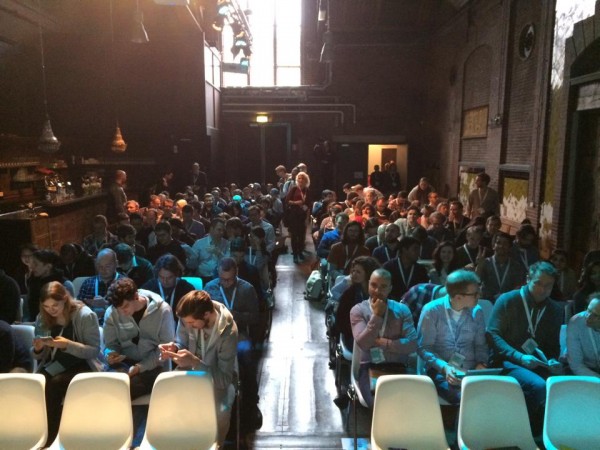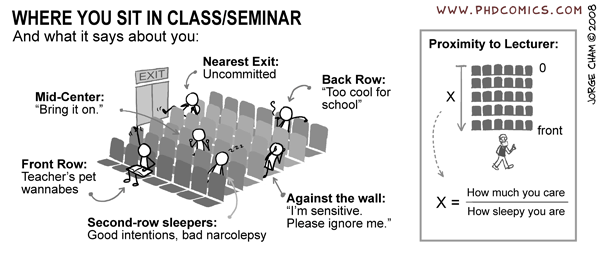The mystery of the front row

Wherever lectures happen, regardless of the size of the venue, most of the front row will be empty. Even when the lecture hall is standing room only (should we be so lucky), many of the seats up front will be vacant. In this photo you can see people standing, looking for seats, but not venturing towards the front.
Now at a rock concert, or sporting event, people would sell their children to get a front row seat. The only time I had front row seats at a basketball game it cost me $300 and I had to watch two bad teams: it was just too expensive to get great seats to see excellent teams.
The front row is almost always empty because:
- We like the freedom to be bored. In the front, there’s nowhere to hide. If we want to nap, pick our nose, read e-mail, we can’t without feeling embarrassed. If the speaker is bad, we’re stuck, for an hour or more, in living hell.
- We’re taught in school to go for the back. People in the front get called on by teachers. Most of us hated that experience, so we hide ourselves in the middle rows.
- We have low confidence in public speakers. We’re doubtful it’s going to be good, and we want the option to leave quickly without embarrassing ourselves.
- The front row feels like part of the show. Sitting within a few feet feels like you are on stage yourself, a feeling most people don’t like. Some people also fear being picked as a volunteer which seems more likely in the front.
- No one can see from the back that the front seats are empty. Unless the organizers, or the speaker, actively helps people find the best seats, the audience might not even know they’re available. The speaker has a much better view of the audience than the audience does.
I suppose it’s a sign of a speaker with a good reputation when people confidently sit in the risky front row.
This diagram below from cartoon phdcomics offers several other theories about where people sit. My favorite part of their analysis is the proximity to lecturer formula, that divides how much you care by how tired you are. Perhaps it would be more accurate to measure how committed you are to the speaker. If you’re 100% convinced you need to listen to the entire lecture, you want the best experience possible. If you’re not sure, or if you’re at an event with multiple tracks, you want the ability to change your mind.

How Do You Fix This Problem?
In Confessions of a Public Speaker, in chapter 4 on how to work a tough room, I explain a technique. All you have to do as the speaker is take responsibility for the room. Ask people to stand up and move. It helps to have free books or Starbucks gift cards, but with some friendly requests and motivation, people will usually do as you ask.
It’s always in the speaker’s interest to improve the room. If people are spread too thin, the room will never feel good. It’s far better to have density near the front, than people sprinkled around a very large room. People need to sit near each other, and close to the stage, to feel like an audience. And as a speaker, you want the audience to feel safe to applaud, laugh and respond to while you’re presenting.
(Photo by Paolo Malabuyo, at IXDA14)

I never sit in the front row because every time I do, one of the following happens:
* The speaker gets too close to the front row during the presentation and talks over my head to the mass of the audience behind me, so I have to crane my head around to see them. (Note the poor fellow twisted around in the front row in your shot above, as the speaker addresses the mass of people sitting in the back and the middle of the room.)
* The speaker actually sits or stands on a chair in the front row at some point during the presentation, so I must awkwardly sit next to them while they sit or kneel on the seat next to me, addressing everyone sitting behind me.
* It turns out the front row was reserved for videotaping/special attendees/whathaveyou and I’m asked to move when all the rest of the seats have filled up.
So I sit in the second row. At least then I can put my feet up on the empty chair in the front row.
Another reason those people might be standing in the back is that they came in late. Out of courtesy they decide not to distract the whole room or you by walking across the front and plopping into a seat. But also notice the buffer zones. When people are not assigned seats (as at a sporting event or theater or even an airplane) they like to leave a buffer zone of one or sometimes even two seats on their left and right. This also creates a situation where the latecomers don’t want to have to step across someone to get to a seat, ironically eliminating the buffer zone in the process. I always encourage my audiences, 5 minutes before I start my presentations, to slide over and eliminate the buffer zone, or prepare to be crossed over by the newcomers until their row is full. :-)
Another: We’re self-conscious. If you’re in the front, lots of people behind you can look at you (much like the speaker, but unintentionally so), but you can’t see what’s happening with the rest of the audience. There’s less sense of being in the crowd, able to share in the collectively approved response to the singular speaker.
I am very conscious of my seating preferences in many situations. Overall I like sitting in the back and at the side so that I can see everything that is happening. Also, I don’t like getting distracted by latecomers (or leavers) making noises behind me. In the case of microphones and slide presentations, I don’t like being blasted or not being able to see because of view too wide.
That said, at a concert last night, I sat in the second row. (Nobody sat in the front row, except some very latecomers who came in during a break.) A completely, totally different kind of event from a lecture.
Franklin: you make a good point. Many rooms are designed for the optimal seat to be 5 rows back.
A key metric might also be the distance from the speaker to the first row: if it’s less than 5 feet it feels awkward to be so close. If the front row is 15 feet back I suspect it’d be filled more often.
Good answers all – I think Mr. Harris’s answer hits a reason I have but hadn’t though about – I like to feel like I’m in the audience and you lose that upfront.
2 more ideas:
Idea 1: The people who arrive early always leave the front row(s) empty because of idea 2. The room starts to fill up. By the time the stragglers arrive they’re too embarrassed to walk past a sea of people to get to the front (especially if they’re late – after the talk has started – and will be seen by colleagues as well as the speaker who may be offended or glare at them). Sitting at the front also means you can’t easily sneak out when the going gets boring.
Idea 2: Unlike music or theatre, the rules of engagement re conference presentations, school lectures and stand up comedy can be very unpredictable. The presenter may at any point pick on you or ask you a question or use you to illustrate something. If you’ve ever seen Dame Edna’s work, you’ll understand why no-one in their right mind would request a “good” seat.
Cheers :-)
r
Speakers often spit while talking out loud. :B
Actually, I beleive you recommend standing in the back. One of your essays on attending profressional conferences mentioned it.
All very good theories.
My personal one is that people, or more typically men, don’t like people to be behind them. It’s a psychological thing about the threat of attack from behind. If you sit in the middle or even at the back, there are less people who may attack you without you knowing. We all know that the chances of being attacked from behind at a talk are slim. However psychological influences run deep. Just a theory!
In a similar vein, in a restaurant men like to set at the back of the restaurant with their back to the wall. In this way they can see what is going on and preempt any attack on their loved one(s). Lastly, men typically like to sleep nearest the door in case they need to jump up and defend the family from attack.
personally, I never sit into to first row, because…. I fear, that the speaker will ask me a question…
yes, that happens all the time, … if the speaker want’s to communicate with the audience, he usually asks a question…and who will he choose to answer?…right, someone from the first row.
The everybody would watch, what I’m answering…
I don’t want to be used like a speaker’s tool (because they try to demonstrate their theory at the most of the time)
that’s all.
I think it’s a school thing and we want to avoid being dragged up in public.
We found that when we put a row of tables in front of the front row, the seats get used effectively. Add power strips and every seat will be taken.
Good design affects behavior? MADNESS.
I’ve had a couple interesting experiences with the front row. I’m one of those people who sit in the front on purpose. I was a really bad student in all those mandatory-to-make-me-a-well-rounded-person classes, so I try to make up for it when I attend something because I care about the subject.
I have been asked to move back because the row is reserved for people being addressed or called on stage, yet wasn’t marked. This causes me to pause now, and make sure I can. If I can’t confirm, and it’s comfortable to sit there, I sit anyway.
I’ve been spat on by presenters. Your body fluids don’t belong on me if I’m not caring for, training, or in an intimate relationship with you. I forget which chapter of Confessions covers that. I moved backward right then.
I’ve also moved back when I realized that the front two row chairs were standard Costco issue folding metal, while the rest of the floor, starting with the third, row was padded with arms. A disincentive to the front for sure.
Yikes – being spit on is sure a good reason to avoid the front. Most lectures are often boring enough that I’d rather be reading (including reading whatever books or essays the speaker has made).
My attention ‘trick’ if you will is to take notes – if I decide I’m going to take notes at an event, and blog them, I can sit just about anywhere. It’s enough of an extra challenge that I’m more patient in how I listen.